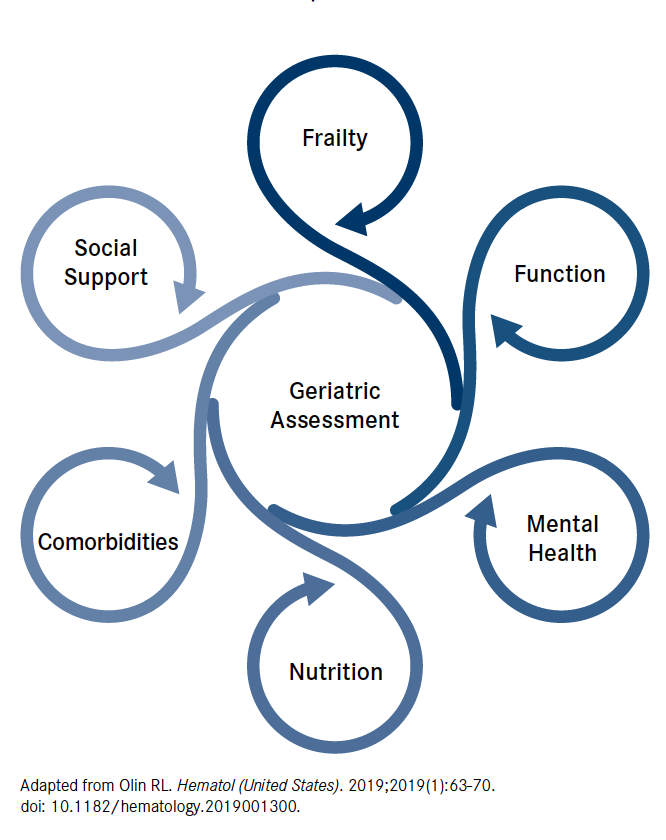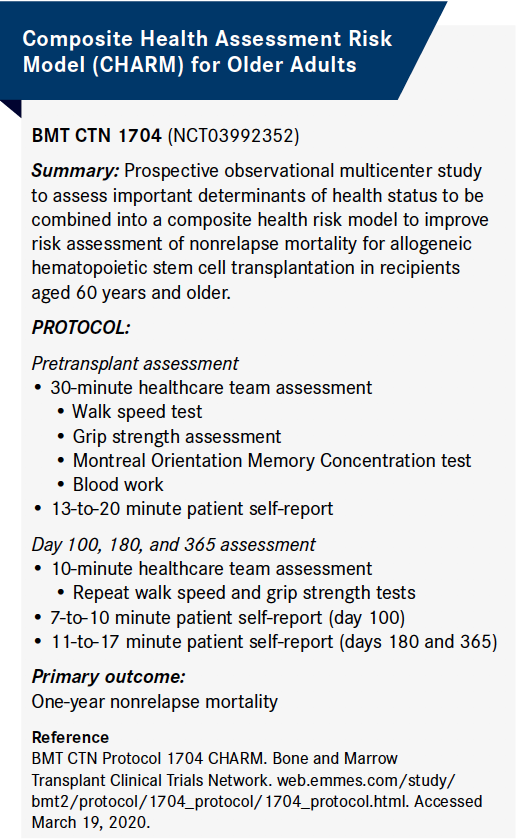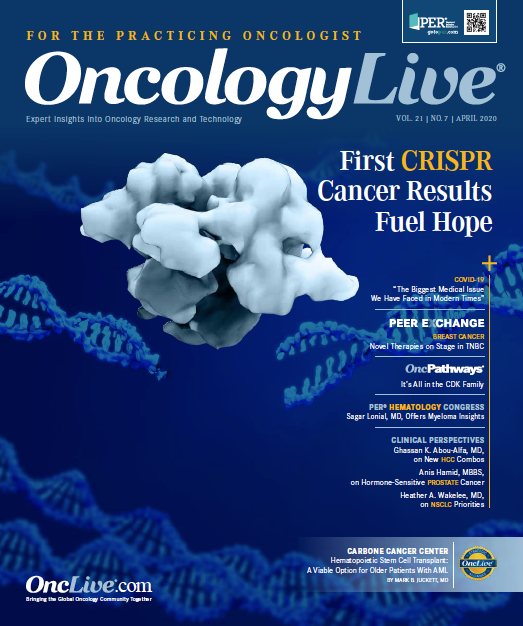Publication
Article
Oncology Live®
Hematopoietic Stem Cell Transplant: A Viable Option for Older Patients With AML
Author(s):
The challenge in caring for older patients is developing a risk-adapted strategy that best meets the patients’ identified goals and accounts for a realistic assessment of hematopoietic stem cell transplantation suitability.

Mark B. Juckett, MD
Vice Chair, Clinical Affairs and Quality, Department of Medicine, University of Wisconsin, and Director, Bone Marrow
Transplant Program, University of
Wisconsin Carbone Cancer Center
Acute myeloid leukemia (AML) is diagnosed at a median age of 68 years, well beyond an age in which intensive therapy and allogeneic hematopoietic stem cell transplantation (HSCT) is typically considered an option. This approach is not easily applied to patients 60 years and older because of limitations caused by comorbidities, performance status, and frailty. In addition, older patients (here defined as those 60 years and older) tend to have disease that is more aggressive, harbors high-risk cytogenetics or molecular lesions (ie, p53 mutations), and is less sensitive to cytotoxic chemotherapy.
Fortunately, the therapeutic landscape for older patients with AML is changing and cure remains a viable goal for many individuals. Several new therapies have been approved by the FDA since 2016 and HSCT is feasible for a growing subset of older patients given the availability of less-toxic preparative regimens, increased donor options, and novel approaches to reduce the risk of graft-versus-host disease (GVHD). The challenge in caring for older patients is developing a risk-adapted strategy that best meets the patients’ identified goals and accounts for a realistic assessment of HSCT suitability.
New agents approved for the treatment of AML include liposomal daunorubicin/cytarabine (Vyxeos) and several targeted agents, including enasidenib (Idhifa), ivosidenib (Tibsovo), midostaurin (Rydapt), gilteritinib (Xospata), glasdegib (Daurismo), and venetoclax (Venclexta).
Although the new agents are promising and better tolerated compared with traditional 7 + 3 induction chemotherapy, they are not expected to lead to long-term remission, and HSCT remains the only option with cure as a realistic goal. If an older patient is a possible candidate for HSCT, the best initial treatment will have the features of maximizing the chance for a deep remission, while sparing the patient the risk of morbidity due to chemotherapy-associated adverse events and neutropenic- related complications.
Although we have no comparative studies between the recently approved novel agents to make evidencebased decisions, the options most likely to lead to complete remissions are midostaurin with 7 + 3 for patients with FLT3-positive AML, liposomal daunorubicin/ cytarabine for AML with myelodysplastic syndrome—like cytogenetic changes, and the combination of venetoclax and a hypomethylating agent. Each of these approaches appears to have advantages over traditional induction and may improve outcome following HSCT.
Using Geriatric Assessment to Determine Candidacy for HSCT
Although debate remains over the particular details of eligibility, a geriatric assessment (GA) of function, frailty, comorbidities, mental health, nutrition, and inflammation appears to be more important than chronological age. The hematopoietic comorbidity index has been validated as a tool to predict nonrelapse mortality after HSCT in patients of all ages and also predicts survival following induction at the time of initial AML diagnosis.1,2
An assessment of frailty among older patients using Lawton’s Instrumental Activities of Daily Living demonstrated a 2.38-fold increase in mortality risk after HSCT3 among those with impairment.
The promise of a comprehensive GA in predicting outcomes among older patients will be tested in BMT CTN Protocol 1704 (NCT03992352), which seeks to collect data on 1100 patients 60 years and older undergoing HSCT. Enrolled patients will undergo a comprehensive GA including inflammatory biomarkers before undergoing HSCT and the association of outcome with specific components of the GA determined. Once completed, the results will help physicians provide guidance to older patients considering HSCT versus nontransplant therapies for AML treatment (Figure4).
Figure. Elements of a Comprehensive Geriatric Assessment (Click to Enlarge)

Nonrelapse Mortality Remains a Concern
The older patient population presents novel challenges to physicians because of the increased nonrelapse mortality associated with intense, myeloablative regimens. A variety of reduced-intensity regimens have been developed, and there continues to be investigation into how “reduced intensity” a regimen can be to optimize the chance of long-term survival.
A randomized comparison of myeloablative versus reduced-intensity regimens showed a relapse-free survival at 18 months of 67.8% versus 47.3%, respectively among patients aged younger than 65 years indicating the importance of regimen intensity.5
Multiple studies have demonstrated rising relapse risk associated with less myelosuppressive regimens. An important principle is to match the intensity of the regimen to the patient’s predicted tolerance, given knowledge about other risk factors for nonrelapse mortality. The physician must tailor the choice of regimen within a desired window of safety, taking into account the patient’s unique features.
Composite Health Assessment Risk Model (CHARM) for Older Adults (Click to Enlarge)

GVHD is the most important long-term risk and responsible for impairing quality of life and increasing morbidity following HSCT. A recent BMT CTN clinical trial identified posttransplant cyclophosphamide, tacrolimus, and mycophenolate mofetil as the most promising novel approach to reducing GVHD risk and improving survival without relapse or GVHD after reduced-intensity HSCT. BMT CTN 1703 (NCT03959241) will compare the long-term GVHD relapse-free survival among patients receiving posttransplant cyclophosphamide/ tacrolimus/mycophenolate mofetil versus conventional tacrolimus and methotrexate. The study will include measures of quality of life to further elucidate the optimal approach to GVHD prophylaxis after reduced-intensity conditioning and the results will establish a new standard for GVHD prevention.
Future Directions
HSCT is increasingly an option for older patients with AML as preparative regimens, donor options, and novel approaches to prevent GVHD have expanded. A variety of so-called reduced-intensity conditioning regimens have been developed and used for HSCT among patients into their mid- to late- 70s. A recent retrospective study compared patients with AML aged 60 to 75 years who underwent reduced-intensity conditioning transplantation with those eligible to be treated with consolidation chemotherapy on cooperative groups’ trials.6 Among patients in first complete remission, survival within the first 9 months was superior among the patients treated with chemotherapy, although beyond 9 months, those treated with HSCT fared better. At 5 years, 29% versus 13.8% of patients were alive after HSCT versus undergoing chemotherapy, respectively.
A recent prospective study of reducedintensity HSCT among patients 60 years and older demonstrated disease-free and overall survival at 2 years of 42% and 48%, respectively.7 Although much remains to be learned regarding patient and donor characteristics, GVHD prevention, and post-HSCT management to improve outcome, HSCT is a viable option for many older patients with AML. n Dr Juckett has developed or assisted in the development of innovative treatment protocols for patients with acute leukemia, myelodysplastic syndrome (MDS), and those needing transplantation. His clinical interests also include other hematologic malignancies and cancer immunotherapy.
Dr Juckett has developed or assisted in the development of innovative treatment protocols for patients with acute leukemia, myelodysplastic syndrome (MDS), and those needing transplantation. His clinical interests also include other hematologic malignancies and cancer immunotherapy.
References
- Savic A, Kvrgic V, Rajic N, et al. The hematopoietic cell transplantation comorbidity index is a predictor of early death and survival in adult acute myeloid leukemia patients. Leuk Res. 2012;36(4):479-482. doi: 10.1016/j.leukres.2011.11.021.
- Giles FJ, Borthakur G, Ravandi F, et al. The haematopoietic cell transplantation comorbidity index score is predictive of early death and survival in patients over 60 years of age receiving induction therapy for acute myeloid leukaemia. Br J Haematol. 2007;136(4):624-627. doi: 10.1111/j.1365-2141.2006.06476.x.
- Muffly LS, Kocherginsky M, Stock W, et al. Geriatric assessment to predict survival in older allogeneic hematopoietic cell transplantation recipients. Haematologica. 2014;99(8):1373-1379. doi: 10.3324/haematol.2014.103655.
- Olin RL. Delivering intensive therapies to older adults with hematologic malignancies: strategies to personalize care. Hematol (United States). 2019;2019(1):63-70. doi:10.1182/hematology.2019001300.55.655.
- Scott BL, Pasquini MC, Logan BR, et al. Myeloablative versus reduced-intensity hematopoietic cell transplantation for acute myeloid leukemia and myelodysplastic syndromes. J Clin Oncol. 2017;35(11):1154-1161. doi: 10.1200/JCO.2016.70.709155.
- Ustun C, Le-Rademacher J, Wang H-L, et al. Allogeneic hematopoietic cell transplantation compared to chemotherapy consolidation in older acute myeloid leukemia (AML) patients 60—75 years in first complete remission (CR1): an alliance (A151509), SWOG, ECOGACRIN, and CIBMTR study [published online May 9, 2019]. Leukemia. 2019;33(11):2599-2609. doi: 10.1038/s41375-019-0477-x.
- Devine SM, Owzar K, Blum W, et al. Phase II study of allogeneic transplantation for older patients with acute myeloid leukemia in first complete remission using a reduced-intensity conditioning regimen: results from Cancer and Leukemia Group B 100103 (Alliance for Clinical Trials in Oncolology)/Blood and Marrow Transplant Clinical Trial Network 0502. J Clin Oncol. 2015;33(35):4167- 4175. doi: 10.1200/JCO.2015.62.7273.










